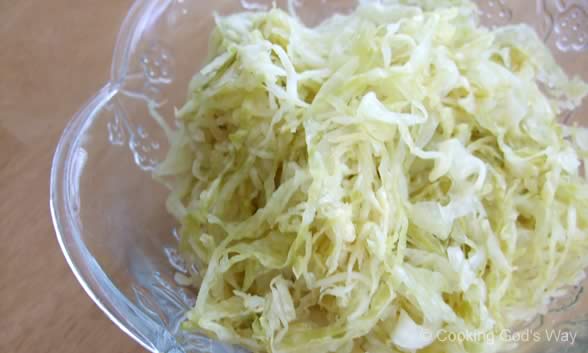"Best Ever" Lacto-fermented Sauerkraut

Prep time
Cook time
Total time
Homemade sauerkraut tastes the absolute best...better than any store-bought version. Sauerkraut is great as a side with just about any meat-based dish, as a snack by itself, or even as a topping on pizza (believe it or not). After many trials I've finally found the secret to really delicious, not to mention easy-to-make sauerkraut (keep reading to find out).
Recipe type: Sides, Condiments
Cuisine: Lacto-fermented, Fermented Foods
Serves: ½ Gallon
Ingredients
- 2½ pounds of very thinly shredded green cabbage (from a 3½ to 4 pound head)
- 1½ Tablespoons Real Salt OR fine Himalayan Salt
- Extra Brine: 1⅛ teaspoons salt + 1 cup filtered water
- You Will Also Need: ½-gallon (2-quart) sized wide-mouth jar (preferably with air-lock lid) and a wooden dowel (food-safe) OR a wooden spoon
Instructions
- Place a few small handfuls of the shredded cabbage into the bottom of ½-gallon jar. Sprinkle this cabbage with a light layer of your sea salt. Gently tamp, pound, the cabbage down in the jar with a flat rolling pin or a wooden spoon. Repeat this until all the cabbage and salt is used up (this should happen at about the same time, so try to use up your salt evenly).
- Loosely cap the jar, set it aside for 30 minutes to allow the cabbage to self-brine.
- Press down on the cabbage with your french rolling pin (or wooden spoon), checking to see how much brine the cabbage made. For best results, place weight(s) on top of the cabbage to hold it down for the fermenting process. You may use one or two Half-Gallon sized Fermentation Weights or several smaller Fermentation Weights.
- Make up the extra brine and pour just enough over the top of the cabbage to completely cover. Keep in mind that the cabbage will soak up some of the brine during the fermenting process, and we want the cabbage to stay moist throughout. If you're unsure, just pour the whole cup of brine over top. If the cabbage still does not seem juicy enough or is not covered by the brine well, then make up another batch of brine to cover.
- Place lid (preferably air-lock lid) on the jar tightly. If using air-lock, fill with water according to instructions. Allow to ferment, at room temperature, for 7 to 10 days, longer if you prefer.
- Remove air-lock lid, if using, and replace with storage lid -- transfer to cold storage (should last up to 6 months if properly stored).
Notes
Makes ½-Gallon.
You can also use red cabbage to make the sauerkraut if you prefer. This makes a milder, slightly sweet, but lovely colored bright "pink" kraut. Please be cautious though as the kraut, and its juices, will stain carpets, clothing etc. just as beets or red wine would.
Homemade sauerkraut turns out best if you shred the cabbage very finely (1 to 2mm thick). This is best done with a mandoline so as to get evenly thin shreds and not "minced" cabbage, which does not work very well, as it tends to float.
If it all possible it is highly recommended that you weigh the cabbage after shredding. You should have 2.5 pounds of shredded cabbage (which after peeling away the outer leaves and coring, you should easily get from a 3.5 to 4 pound head). So if you can, invest in a kitchen scale.
You can also use red cabbage to make the sauerkraut if you prefer. This makes a milder, slightly sweet, but lovely colored bright "pink" kraut. Please be cautious though as the kraut, and its juices, will stain carpets, clothing etc. just as beets or red wine would.
Homemade sauerkraut turns out best if you shred the cabbage very finely (1 to 2mm thick). This is best done with a mandoline so as to get evenly thin shreds and not "minced" cabbage, which does not work very well, as it tends to float.
If it all possible it is highly recommended that you weigh the cabbage after shredding. You should have 2.5 pounds of shredded cabbage (which after peeling away the outer leaves and coring, you should easily get from a 3.5 to 4 pound head). So if you can, invest in a kitchen scale.
Recipe by Cooking God's Way at https://www.cookinggodsway.com/best-ever-lacto-fermented-sauerkraut/